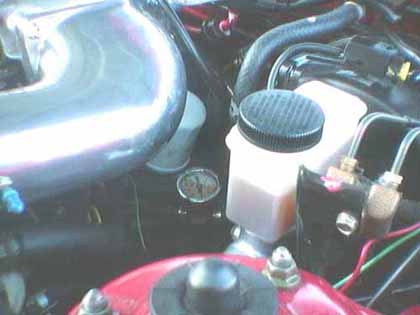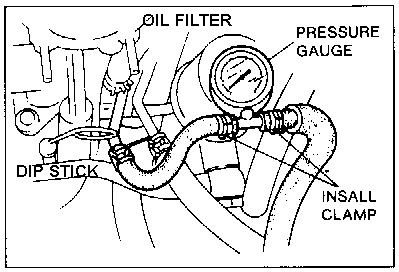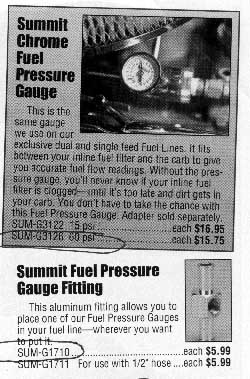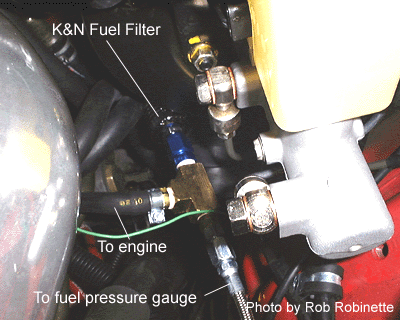How To Install a Fuel Pressure Gauge
By Rob Robinette
Installing this engine-bay mounted fuel pressure gauge is
straightforward. You will need a 60 (or 100) psi gauge, a gauge fitting for a 3/8 inch
fuel hose, and two 3/8 inch hose clamps. The fuel lines are actually 5/16 inch inside
diameter hoses but the 3/8 inch gauge fitting will fit. I ordered the parts from
Summit Racing (800 230-3030) for about $25.

Fuel pressure gauge mounted at the
fuel line (yes, I flushed the brake fluid)

The diagram from the Work Shop
Manual

The gauge (liquid filled) and
fitting from Summit Racing: Gauge - part # SUM-G3126 and Fitting - part # SUM-G1710 (for
3/8 inch hoses). Summit also sells AutoMeter fuel pressure gauges.
Put about two wraps of Teflon tape on the gauge's
threads and screw it into the gauge fitting. Make sure the tape doesn't extend below the
threads, you don't want any of the tape getting into the fuel lines. Hand tight will not
be enough so use a large wrench or vise to hold the fitting and a small wrench to screw in
the gauge.

K&N fuel filter, AN-6 to 1/4
inch NPT adapter, 1/4 inch NPT 3 way adapter
Summit Racing sells a three foot AN-4 stainless steel
fuel line to remote mount the gauge for about $30. Using this fuel line you can tape the
gauge to your windshield for engine tuning. You'll need to get at least one insulated
(rubber-lined) hose clamp to secure the line and gauge in the engine compartment. There
are several pre-tapped 10mm bolt holes on the fender to bolt the fuel line down (see
below).

AN-4 fuel line and gauge
Try to do this with as little fuel in the tank as
possible to minimize fuel spill. The fuel line you want to tap in to is the fuel line
closest to the oil dip stick (see diagram above). It is a rubber hose that connects to a
metal pipe near the engine. Before you start cutting the hose you have to release the fuel
pressure so see the Release
Fuel Pressure How-To for instructions. Now you can cut the
fuel line but use a rag to keep fuel from spraying on you and have two 5/16 inch plugs
ready to stop the fuel flow, two Bic pen type caps will work fine. The fuel will dribble
out continuously unless you plug the hoses. The fuel lines have an insulation tube wrapped
around them which makes them look larger than 5/16 inch. I had to remove the insulating
tube from the fuel line so I could get the clamps on the hose. The insulation tube will
come right off after you cut the fuel line. After installing the gauge and tightening the
clamps you need to prime the fuel system. See the Release Fuel Pressure How-To for instructions. Make sure there isn't any pooled fuel anywhere
before you start the engine. Take a good look for fuel leaks and enjoy.
Normal idle fuel pressure is 28-32 psi. Pressure with
the F/P (fuel pump) and GND (ground) diagnosis terminals
jumpered should be 36-38 psi (see the Release Fuel Pressure How-To for
info). You can check maximum fuel pressure (71-107 psi) by plugging (pinching) the fuel
line on the engine side of the fuel gauge.
WARNING
DO NOT ROUTE A FUEL LINE INTO THE COCKPIT!
TO PLACE A FUEL GAUGE IN THE COCKPIT YOU MUST USE AN ISOLATOR OR AN ELECTRICAL
GAUGE WITH A SEPARATE PRESSURE SENDER.
If you are installing an electric pressure gauge you
can install the pressure sender in the same place in the same way and then route the
output wire through the firewall to the gauge.
Rob Robinette
|